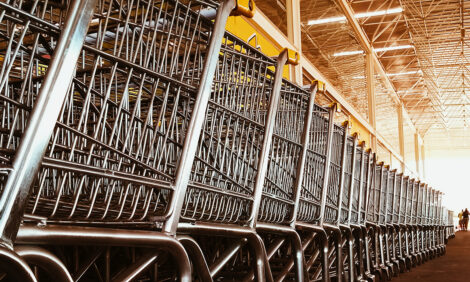



Pork Commentary: China, China, China
CANADA - The pork market has been being driven by huge speculation that China will purchase large amounts of pork to ease inflationary, social and economic pressures caused by hog prices in China of over $1.15 US lb.When pork is your main meat protein staple for over a billion people, it is a big factor in the world’s pork supply and demand. Escalating food price inflation in not only China, but in the world is a dynamic factor that is driving market demand and psychology.
Some Observations on World Food Demand
Dean Foods Co. is the largest milk processor in the United States. Its profits dropped last quarter, according to CEO Greg Engles, due to higher raw milk prices. CEO Engles said “Dean is being challenged by the most stubbornly inflationary dairy markets in history. A global phenomenon that feels like a perfect storm and it isn’t over. The culprit rising costs to feed the cows.”
Donald Coxe, the global portfolio strategist for BMO Financial Group, “This week’s stock market volatility is a crisis for the elites, not the average investors.” Mr.Coxe said, “This is not 1987. We’ll come out of this because the global economy is fundamentally stronger.”
“The bigger story now is the global shortage of grains because of the changing diets, particularly of Chinese and Indians” he added “not to mention a surge in demand for bio-fuels derived from grains.”
Market watchers have come to accept the torrid economic growth in India and China has led to soaring oil and base metal prices, but “What they didn’t expect is that these people would give up living on bowls of rice and pampadums.” Mr. Coxe said.
Now they want meat and milk. Global consumption is up more than 3% and 2%, respectively, on average over the past three years, according to the USDA. And the size of the emerging middle class eating those newly affordable foods continues to expand dramatically. According to McKinsey Quarterly, the number of urban Chinese households qualifying as middle class rose to 42 million in 2005, from 7.6 million in 1995 and will hit 199 million households in 2015. All in a country that loves pork.
“They gave us cheap toys, t shirts, socks and technology. But they will raise prices of our food and keep them high because they want to eat the way we do.” said Mr. Coxe. “Costs will rise across the economy, and 20 years of disinflation are coming to an end, worldwide. The new story is food.”
Mr. Coxe, who predicted the boom in base metals and oil prices five years ago, is a person to heed.
It makes sense what Mr. Coxe says, with 2 billion people in China and India gaining buying power from improved financial conditions, it doesn’t take a rocket scientist to figure they will eat more food. Just as US per capita meat consumption (boneless) has gone from 150 lbs in 1960 to over 200 lbs per annum, as standards of living improve, so will China and India. A growing global economy and greater disposal income will absolutely increase meat and pork demand and consumption. The surge in pricing we have seen in agriculture commodities is just the tip of the iceberg of what will happen over the next decade. The thirty year price surges and price plateaus that we have had every three decades, for the last 150 years are in place. Isn’t it great that we are the pork industry, with so many opportunities in the foreseeable future?
Productivity
We thought it would be interesting to compare older Pig Champ databases to the most recent to see where productivity is moving in the US industry. The oldest Pig Champ database we could get was 1998. In our opinion, the comparison is relative. Pig Champ producers in both 1998 and 2006 are ones that are pushing hard to improve productivity and are, in our opinion, probably as a group, better than industry average.
USA Pig Champ
| Annual Year-End Summary | ||
|---|---|---|
| Median | ||
| 1998 | 2006 | |
| Number of Herds | 612 | 493 |
| Farrowing Rate % | 74.8 | 79.4 |
| Total born per litter | 11.2 | 12.05 |
| Total born alive per litter | 10.2 | 10.8 |
| Piglets weaned per litter | 9.1 | 9.42 |
| Pre-weaning mortality % | 12.9 | 11.98 |
| Piglets age at weaning | 18.3 | 19.4 |
| Piglets weaned/mated, female per year, median |
20.1 | 22.0 |
| Piglets weaned/mated, female per year, top 10% |
22.8 | 24.7 |
| % sow deaths per year | 5.3 | 8.4 |
| % cull per year | 43.6 | 47.9 |
| Average female inventory | 460 | 665 |
Observations
- Litter size in 2006 was higher in all categories, total born, born alive, and weaned. Probably a reflection of better management and increased genetic capacity.
- Average weaning age has gone up by a day.
- Farrowing rate has increased 5% over the last 8 years which is significant. Why? Better management? AI? Genetic capacity?
- Pigs weaned/mated per female per year is up 1.9 pigs or about 10%, just over a 1% improvement per year. Better management and increased genetic capacity would be our guess.
- In 2006, the top 10% herds on Pig Champ weaned 24.7, up 1.9 pigs from 1998. The same increase as the median average. To wean 25 pigs plus in 2006 puts you up in the top 6% of all producers who submit data. In the big picture of the whole industry, 25 pigs plus probably puts you in the top 3-4% of all producers.
- One point which the Pig Champ shows disappointing results is sow death loss. Going from 5.3% in 1998 to 8.4% in 2006. A reflection of the huge influx of European (French) genetics that have increased the capacity to have pigs born, but are not as durable.
- Finally, Pig Champ 2006 has fewer farms but bigger farms. That is truly a reflection of the changes over the last 8 years.
Markets
Iowa-Minnesota was 68.24 lean on Friday, down 1.00 from the previous week. Slaughter was over 2 million head. Weights are almost 2 lbs a head higher than a year ago. There are lots of hogs with lean hog futures October 70.50 and December 69.45. The market is counting on big exports this fall. We think there will be large exports. There better be.







